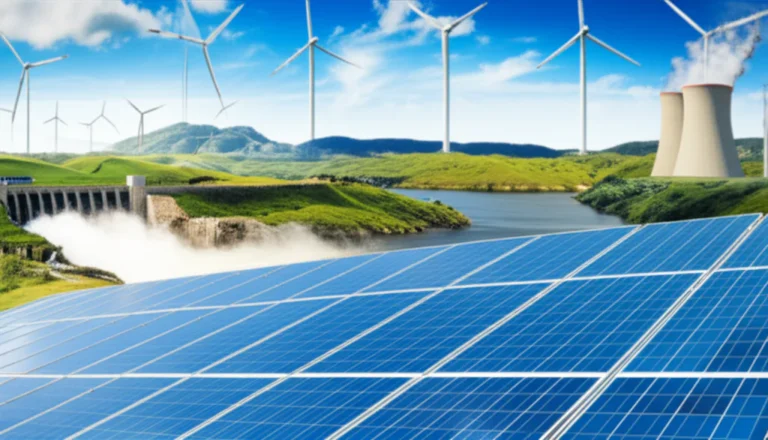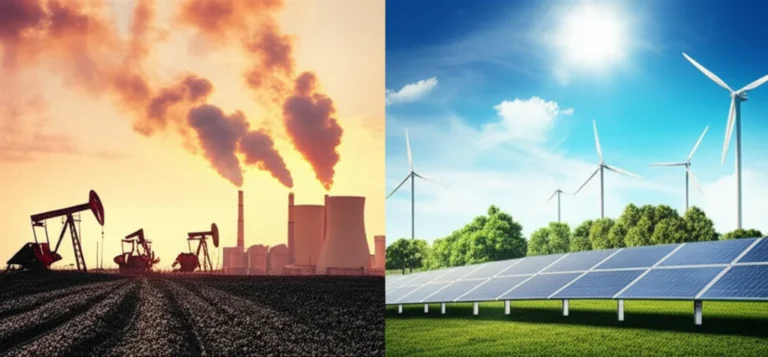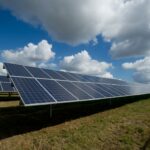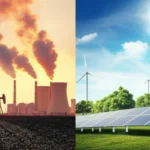Support our educational content for free when you purchase through links on our site. Learn more
Is Nuclear Energy Renewable? 7 Surprising Facts You Need to Know ⚛️ (2025)
Imagine a power source that can light up entire cities without pumping carbon into the atmosphere — sounds like a dream, right? But here’s the twist: is nuclear energy truly renewable, or is it just a clever masquerade? At Gone Greenish™, we’ve dug deep into this atomic puzzle to uncover the truth behind nuclear power’s green credentials. Spoiler alert: it’s not as black-and-white as you might think! From uranium’s finite nature to cutting-edge reactor tech, we’ll unravel the mystery and reveal why nuclear energy might just be the unexpected hero in our fight against climate change.
Ready to challenge what you thought you knew? Stick around as we explore 7 surprising facts about nuclear energy’s renewability, environmental impact, and future potential. Whether you’re a green enthusiast, a student, or just curious, this guide will power up your knowledge and help you make informed decisions about our planet’s energy future.
Key Takeaways
- Nuclear energy is not renewable in the traditional sense because it relies on finite uranium fuel.
- Despite this, it produces near-zero carbon emissions, making it a powerful tool against climate change.
- Nuclear power provides reliable baseload electricity, complementing intermittent renewables like solar and wind.
- Advances in technology, such as Small Modular Reactors (SMRs) and thorium reactors, promise a safer and more sustainable nuclear future.
- Managing nuclear waste remains a challenge but is addressed through secure storage and recycling innovations.
- A balanced energy mix including nuclear and renewables is essential for a sustainable, low-carbon future.
👉 CHECK PRICE on:
Table of Contents
- ⚡️ Quick Tips and Facts: Your Nuclear Energy Cheat Sheet
- ⚛️ The Atomic Dawn: A Brief History of Nuclear Power Generation
- 🤔 Is Nuclear Energy Renewable? Unpacking the Core Question
- 🔬 Unlocking the Atom: How Nuclear Fission Powers Our World
- 💡 The Bright Side: Compelling Benefits of Nuclear Power
- 🌍 Green or Grey? Nuclear Energy’s Environmental Footprint Beyond Emissions
- 🚧 Safety First? Addressing Nuclear Power Plant Risks and Regulations
- ☢️ The Elephant in the Room: Managing Nuclear Waste
- 💰 The Price Tag: Economic Realities of Nuclear Power
- 🔄 Nuclear vs. Renewables: A Head-to-Head Showdown for Our Energy Future
- 🚀 Beyond Today: The Future of Nuclear Energy and Advanced Reactor Technologies
- 🌐 Nuclear Power Around the World: A Global Snapshot
- 🛑 Roadblocks Ahead: Challenges Facing Nuclear Energy’s Expansion
- ✅ Our Take: Is Nuclear Energy Part of a Green Future?
- Conclusion: Powering Tomorrow, Responsibly
- Recommended Links: Dive Deeper!
- FAQ: Your Burning Questions Answered
- Reference Links: Our Sources
⚡️ Quick Tips and Facts: Your Nuclear Energy Cheat Sheet
To get started on your journey to understanding nuclear energy, check out our quick tips and facts below. For more information on renewable energy, visit our article on 7 Must-Know Renewable Energy Facts for Students (2025).
Here are some key points to consider:
- Nuclear energy is a low-carbon source of electricity, producing nearly zero greenhouse gas emissions during operation.
- It is not considered renewable because it uses finite resources like uranium.
- Nuclear power plants can operate continuously, providing a reliable source of electricity.
- The use of nuclear energy can help reduce our reliance on fossil fuels and decrease carbon emissions.
Benefits of Nuclear Energy
Some of the benefits of nuclear energy include:
- Reliability: Nuclear power plants can operate continuously, providing a reliable source of electricity.
- Low Carbon Emissions: Nuclear energy produces nearly zero greenhouse gas emissions during operation.
- Energy Independence: Nuclear power can reduce our reliance on fossil fuels and decrease carbon emissions.
Comparison of Energy Sources
Here’s a comparison of different energy sources:
| Energy Source | Carbon Emissions | Reliability |
|---|---|---|
| Nuclear | Low | High |
| Solar | Low | Medium |
| Wind | Low | Medium |
| Fossil Fuels | High | High |
⚛️ The Atomic Dawn: A Brief History of Nuclear Power Generation

Nuclear power has a rich history, dating back to the 1950s. The first commercial nuclear power station was Calder Hall in Great Britain, which began operation in 1956. Since then, nuclear energy has become a significant contributor to the global energy mix.
Milestones in Nuclear Energy
Some notable milestones in the history of nuclear energy include:
- 1956: The first commercial nuclear power station, Calder Hall, begins operation in Great Britain.
- 1970s: Nuclear energy becomes a major source of electricity in countries like France and the United States.
- 2011: The Fukushima Daiichi nuclear disaster highlights the importance of safety and regulation in the nuclear industry.
🤔 Is Nuclear Energy Renewable? Unpacking the Core Question
The question of whether nuclear energy is renewable is a complex one. While it is a low-carbon source of electricity, it uses finite resources like uranium, making it non-renewable.
1. Defining “Renewable Energy”: What Does It Really Mean?
Renewable energy refers to energy sources that are constantly replenished and considered inexhaustible over time. Examples include solar, wind, and hydroelectric power.
2. The Non-Renewable Nature of Uranium: Fueling the Debate
Uranium is a finite resource, and its use in nuclear power plants makes nuclear energy non-renewable. However, some argue that nuclear energy can be considered a “stock energy” because uranium is abundant and can be recycled.
3. The “Sustainable” Argument: A Different Lens on Nuclear Power
While nuclear energy may not be renewable, it can be considered sustainable due to its low carbon emissions and ability to provide reliable electricity. For more information on sustainable energy, visit our category on Eco-Conscious Brands.
🔬 Unlocking the Atom: How Nuclear Fission Powers Our World
Nuclear fission is the process by which atomic nuclei split to release energy. This energy is then used to heat water, producing steam that drives turbines to generate electricity.
The Nuclear Fission Process
The nuclear fission process involves the following steps:
- Fuel Preparation: Uranium fuel is prepared and loaded into the reactor.
- Fission Reaction: The uranium fuel undergoes a fission reaction, releasing energy.
- Heat Transfer: The energy is transferred to a coolant, which heats water to produce steam.
- Electricity Generation: The steam drives turbines to generate electricity.
💡 The Bright Side: Compelling Benefits of Nuclear Power
Nuclear power has several benefits, including reliability, low carbon emissions, and energy independence.
1. Zero Carbon Emissions: A Climate Change Champion
Nuclear energy produces nearly zero greenhouse gas emissions during operation, making it a valuable tool in the fight against climate change. Visit our category on Climate Change for more information.
2. Reliable Baseload Power: Always On, Always Ready
Nuclear power plants can operate continuously, providing a reliable source of electricity. This makes them an ideal complement to intermittent renewable energy sources like solar and wind.
3. Energy Independence & Security: Less Reliance on Volatile Markets
Nuclear power can reduce our reliance on fossil fuels and decrease carbon emissions, making it a valuable tool for energy independence and security.
4. Small Land Footprint: More Power, Less Space
Nuclear power plants require a relatively small amount of land to operate, making them a more efficient use of space compared to other forms of energy production.
🌍 Green or Grey? Nuclear Energy’s Environmental Footprint Beyond Emissions
While nuclear energy is often considered a low-carbon source of electricity, its environmental footprint extends beyond emissions.
The Impact of Nuclear Waste
Nuclear waste is a significant environmental concern, as it requires safe storage and disposal to prevent contamination. For more information on reducing waste, visit our category on Conservation Tips.
The Importance of Regulation
Regulation plays a crucial role in ensuring the safe operation of nuclear power plants and minimizing their environmental impact. Visit our category on Carbon Footprint Reduction for more information on reducing your carbon footprint.
🚧 Safety First? Addressing Nuclear Power Plant Risks and Regulations
Nuclear power plants pose unique safety risks, including the potential for accidents and the storage of radioactive waste.
1. Understanding Nuclear Accidents: Lessons from History
Nuclear accidents like Chernobyl and Fukushima highlight the importance of safety and regulation in the nuclear industry.
2. Robust Safety Protocols and Regulatory Oversight
Robust safety protocols and regulatory oversight are essential for minimizing the risks associated with nuclear power plants.
☢️ The Elephant in the Room: Managing Nuclear Waste
Nuclear waste is a significant challenge facing the nuclear industry, requiring safe storage and disposal to prevent contamination.
1. Types of Nuclear Waste: Not All Glow in the Dark
There are several types of nuclear waste, including low-level, intermediate-level, and high-level waste.
2. Current Storage Solutions: Deep Geological Repositories and Beyond
Current storage solutions include deep geological repositories, which provide a safe and secure method for storing nuclear waste.
💰 The Price Tag: Economic Realities of Nuclear Power
The economic realities of nuclear power are complex, involving significant upfront costs and ongoing expenses.
The Cost of Building a Nuclear Power Plant
The cost of building a nuclear power plant can be substantial, requiring significant investment and financing. For more information on the economic benefits of renewable energy, visit our category on Green Home.
The Cost of Operating a Nuclear Power Plant
The cost of operating a nuclear power plant includes fuel, maintenance, and staffing expenses.
🔄 Nuclear vs. Renewables: A Head-to-Head Showdown for Our Energy Future
The debate between nuclear and renewable energy sources is ongoing, with each having its advantages and disadvantages.
The Benefits of Renewable Energy
Renewable energy sources like solar and wind are becoming increasingly cost-competitive with fossil fuels, offering a cleaner and more sustainable alternative.
The Benefits of Nuclear Energy
Nuclear energy provides a reliable and low-carbon source of electricity, making it an ideal complement to intermittent renewable energy sources.
🚀 Beyond Today: The Future of Nuclear Energy and Advanced Reactor Technologies
The future of nuclear energy is exciting, with advances in reactor technology and safety.
1. Small Modular Reactors (SMRs): Game Changer or Hype?
Small modular reactors (SMRs) offer a promising new approach to nuclear energy, providing a smaller, more efficient, and cost-effective alternative to traditional reactors.
2. Molten Salt Reactors & Thorium: Unlocking New Possibilities
Molten salt reactors and thorium offer new possibilities for nuclear energy, providing a safer, more efficient, and sustainable alternative to traditional reactors.
3. The Holy Grail: Nuclear Fusion Energy
Nuclear fusion energy is the holy grail of energy production, offering a nearly limitless source of clean and sustainable energy.
🌐 Nuclear Power Around the World: A Global Snapshot
Nuclear power is a global industry, with countries like France, the United States, and Japan relying heavily on nuclear energy.
The Global Nuclear Energy Market
The global nuclear energy market is complex, involving a range of countries and companies. For more information on the global energy market, visit the International Energy Agency (IEA) website.
The Future of Nuclear Energy
The future of nuclear energy is uncertain, with advances in technology and safety offering new possibilities for this low-carbon source of electricity.
🛑 Roadblocks Ahead: Challenges Facing Nuclear Energy’s Expansion
Despite its benefits, nuclear energy faces several challenges, including public perception, safety concerns, and economic competition from renewable energy sources.
The Challenge of Public Perception
Public perception is a significant challenge facing the nuclear industry, with many people concerned about safety and environmental risks.
The Challenge of Safety Concerns
Safety concerns are a major challenge facing the nuclear industry, with the risk of accidents and radioactive waste requiring careful management and regulation.
✅ Our Take: Is Nuclear Energy Part of a Green Future?
At Gone Greenish, we believe that nuclear energy can play a role in a green future, providing a reliable and low-carbon source of electricity.
The Importance of a Balanced Energy Mix
A balanced energy mix is essential for a green future, involving a combination of renewable energy sources, nuclear energy, and energy efficiency measures.
The Need for Sustainable Energy Solutions
Sustainable energy solutions are essential for a green future, requiring a commitment to reducing carbon emissions and promoting energy efficiency.
For more information on sustainable energy solutions, visit our category on Eco-Conscious Brands.
To learn more about nuclear energy and its role in a green future, check out the World Nuclear Association website.
👉 CHECK PRICE on:
- Nuclear Energy Books on Amazon | Nuclear Energy Books on Walmart | Nuclear Energy Books on Etsy
- Nuclear Energy Courses on Udemy | Nuclear Energy Courses on Coursera | Nuclear Energy Courses on edX
Conclusion: Powering Tomorrow, Responsibly

So, is nuclear energy renewable? The short answer: No, not in the traditional sense. It relies on finite uranium resources, which means it doesn’t tick the classic “renewable” box like solar or wind. But here’s the twist — nuclear energy is a low-carbon powerhouse that can provide steady, reliable electricity around the clock. It’s like the dependable friend who shows up rain or shine, unlike solar and wind, which depend on the weather’s mood.
At Gone Greenish™, we see nuclear energy as a critical bridge in the transition to a greener future. It complements renewables by filling in the gaps when the sun isn’t shining or the wind isn’t blowing. Plus, with innovations like Small Modular Reactors (SMRs) and advances in recycling spent fuel, nuclear power is evolving toward being safer, more efficient, and potentially more sustainable.
Of course, it’s not without challenges — from nuclear waste management to public perception and high upfront costs. But with robust regulations, technological advancements, and a balanced energy mix, nuclear energy can be a key player in achieving net-zero emissions and energy security.
So, while nuclear energy may not be “renewable” in the strictest sense, it’s undeniably a valuable, low-carbon energy source that deserves a seat at the green energy table. Ready to dive deeper? Keep exploring, stay curious, and power your knowledge with us!
Recommended Links: Dive Deeper!
Looking to expand your nuclear energy know-how or find resources to fuel your eco-conscious journey? Check out these curated links:
-
Nuclear Energy Books on Amazon:
Explore titles on nuclear energy | Walmart | Etsy -
World Nuclear Association:
Official Website -
Orano Group – Nuclear Power & Renewability:
Is nuclear power a renewable energy?
FAQ: Your Burning Questions Answered

Is nuclear energy a sustainable source of power for the future?
Absolutely, with caveats! While nuclear energy isn’t renewable, it can be sustainable if managed responsibly. Recycling spent fuel (like the MOX fuel used in France) and developing advanced reactors such as SMRs and thorium reactors can extend fuel supplies and reduce waste. Sustainability also hinges on strict safety protocols and effective waste management, which are improving continuously.
Read more about “🌿 7 Must-Know Renewable Energy Facts for Students (2025)”
What are the environmental impacts of nuclear energy on our planet?
Nuclear power plants produce minimal greenhouse gas emissions during operation, making them climate-friendly compared to fossil fuels. However, environmental concerns include the mining of uranium, potential radioactive contamination from accidents, and the long-term storage of nuclear waste. Deep geological repositories and improved waste recycling technologies are mitigating these impacts.
Read more about “Is Clean Energy the Same as Renewable Energy? 7 Surprising Facts (2025) ⚡️”
Can nuclear energy help reduce greenhouse gas emissions and mitigate climate change?
✅ Yes! Nuclear energy is one of the largest sources of low-carbon electricity worldwide. It emits virtually no CO₂ during operation, helping countries reduce their carbon footprint. For instance, France generates about 70% of its electricity from nuclear power, significantly lowering its emissions compared to fossil-fuel-reliant nations.
How does nuclear energy compare to other forms of renewable energy, such as solar and wind power?
Nuclear energy provides constant, reliable baseload power, unlike solar and wind, which are intermittent and weather-dependent. However, nuclear plants require more complex infrastructure, higher upfront costs, and produce radioactive waste. Solar and wind are more scalable and have lower environmental risks but need storage solutions to match nuclear’s reliability.
What role can nuclear energy play in promoting energy independence and reducing reliance on fossil fuels?
Nuclear power can reduce dependence on imported fossil fuels by providing a stable domestic energy source. This enhances energy security and shields economies from volatile fossil fuel markets. Countries like the U.S. and France leverage nuclear energy to diversify their energy portfolios and maintain steady electricity supplies.
Are there any health risks associated with nuclear energy production and disposal of radioactive waste?
While nuclear accidents are rare, their consequences can be severe, as seen in Chernobyl and Fukushima. Modern reactors have enhanced safety features to minimize risks. Radioactive waste disposal requires careful handling and long-term storage to protect human health and the environment. Regulatory agencies worldwide enforce strict standards to safeguard public health.
Can nuclear energy be considered a clean and healthy source of power for a sustainable future?
Nuclear energy is clean in terms of air pollution and greenhouse gas emissions, but the health and environmental risks associated with accidents and waste management cannot be ignored. When balanced with renewables and managed responsibly, nuclear power can be part of a clean energy mix that supports a sustainable future.
Reference Links: Our Sources
- National Grid: What is nuclear energy and why is it considered clean energy?
- Natural History Museum: Is nuclear energy renewable?
- Orano Group: Is nuclear power a renewable energy?
- World Nuclear Association: Nuclear Power in the World Today
- International Energy Agency (IEA): Nuclear Power
- U.S. Nuclear Regulatory Commission: Nuclear Power Plants
Thanks for sticking with us on this atomic adventure! Remember, the future of energy is a mix — and nuclear energy, while not renewable, is a powerful piece of the puzzle in building a cleaner, greener planet. 🌍⚡






